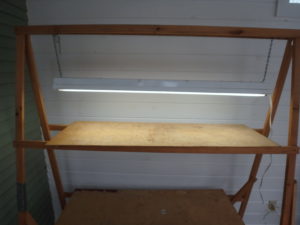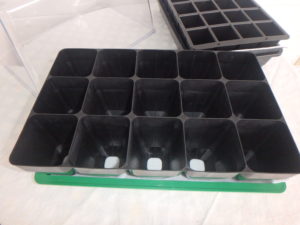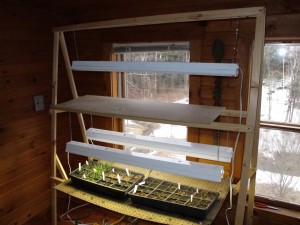Starting Seedlings
You can’t keep plants happy on a windowsill for 6 to 16 weeks. You will need special indoor lighting and a plant stand of some sort if you do many plants. Fluorescent lights are the standard for home growers. I have purchased four-foot fixtures that hold 2 tubes each. I hang them in an A-frame plant stand I built myself that will accommodate 10 flats of plants and 5 light fixtures.
This year I am making a big push NOT to buy anything plastic that is not reusable by me. That means no flimsy six-packs for seeds. I got some heavy duty, reuseable plastic flats from Gardeners Supply last year, and like those a lot. They are also self-watering, which takes off the pressure to track the moisture of every plant every day. They are called the ”GroEase” system, with either 24 large cells or 15 extra-large cells per flat.
Here’s my recipe for the soil blocks: In a wheelbarrow or large plastic storage bin mix 10 quarts dry peat moss, 3 quarts sand and ¼ cup agricultural limestone (powdered, not pelletized is preferred, but either is OK). Mix in ¼ cup of each of these: dried blood, rock phosphate, green sand and granite dust or Azomite (optional). Instead of all those, you could substitute 1 cup organic fertilizer. Then add and mix in: 10 quarts peat humus, 10 quarts fine compost (your own or purchased) and 10 quarts top soil (your own is preferred, but purchased is OK).
Starting Seeds Indoors
Wind in the Willows, one of my favorite children’s books, has a great quote that came to me recently. The water rat says to his friend, the mole, “Believe me, my young friend, there is NOTHING–absolutely nothing–half so much worth doing as simply messing about in boats. Simply messing,’ he went on dreamily: `messing–about–in–boats; messing—-“. At that point he crashes into the bank and comes back to reality.
What, you might fairly ask, does that have to with gardening? Well, at this time of year I would substitute the word “seeds” for “boats”. Messing about with seeds is wonderful – for the soul, for the mind, and later –for your garden. It’s time now to start planting seeds indoors for summer vegetables.
I generally plant tomato seeds indoors around April 10, sometimes a bit sooner, for planting outdoors 8 weeks later. I have already planted onions, celeriac, a few special peppers and lots of lisianthus (an annual cutflower). Those all need more than 8 weeks. Later, 4-5 weeks before planting time in June, I will start my squash and cucumber seeds in 3-inch pots. By starting them indoors and putting out good-sized plants (they grow fast) I am able to prevent them from being eaten up by striped cucumber beetles. Those beetles can devour a freshly germinated seedling outdoors in a single night – but won’t do much to plants with 6-inch vines.
There are a couple of keys to success growing tomatoes and other seedlings indoors. Most important is having adequate light. You really cannot grow healthy seedlings by depending on sunlight on a windowsill. You need lights – either the new-fangled LED lights for plants, or T-8 fluorescent fixtures that are 4-feet long and provide good light for seedlings. You do not need those special (read expensive) “Gro-Light” bulbs with special wave lengths (equivalent to the sun) for starting seedlings.
Last year in my column I wrote directions for building a simple A-frame plant stand, so will not repeat them this year. You may find it at my web site, www.Gardening-Guy.com. Just go to the search engine box and type in plant stand. Or, if you prefer, design your own or buy a light stand from your local garden center or from Gardeners Supply (www.gardeners.com). But you do need lights to succeed.
It is also critical that seeds and the potting mix you use do not dry out, especially when the seeds are just starting to open up and send out little roots and shoots. They are particularly vulnerable then. So check your seeds every day and water as needed.
You may also get clear plastic covers to fit over your growing flats. These allow light to pass, but hold in water. Water will evaporate, then condense on these covers and rain down gently on your seedlings. You could accomplish the same effect with plastic wrap but then, as they germinated, the plants would butt heads with the wrap. The plastic covers provide an inch or two of growing space, allowing some to grow while others are still waking up.
Commercially prepared seed starting mix is largely composed of peat moss. Peat moss has no “food value” to plants. It provides a light, airy space that roots find easy to penetrate, and it holds water. Most have some fertilizer added, but this soon disappears either by washing away or being used up by the plants. So, as your plants get bigger, plan on giving them some liquid fertilizer – or they will languish.
Seaweed or fish fertilizers are readily available, and are better than chemical fertilizers – they provide a full menu of minerals, including the micronutrients important for plants. Fish fertilizers may offend some delicate noses when growing plants indoors, however.
An alternative to growing seedlings in straight potting mix is to mix it 50-50 with compost. It probably makes sense to buy compost for this even if you make your own. Why? Because commercial compost should be weed-free and your own compost probably is not. Unless you know what each seedling looks like when it first germinates, you may end up babying weeds along – or pulling out your seedlings. This can be a real problem if growing flowers that you have not grown before.
Lastly, think about planting seeds by the position of the stars and moon. I know, I know, it sounds pretty “out there”. But last year I used the Stella Natura (www.stellanatura.com) planting calendar which uses biodynamic principles to determine when to plant or transplant, and I saw real differences when I experimented with planting in the designated blackout times. Seeds are still one of life’s mysteries – all that life packaged in such a small container. Who knows what really affects them? Not me, that’s for sure.
Henry may be reached at henry.homeyer@comcast.net. His web sites are www.Gardening-guy.com and www.henryhomeyer.com.






